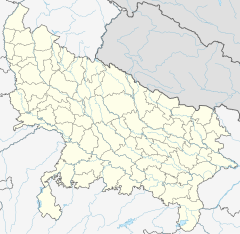| Digamber Jain Bada Mandir Hastinapur | |
|---|---|
 Main Entrance Gate 'Singh Dwaar' of the Temple Complex | |
| Religion | |
| Affiliation | Jainism |
| Sect | Digambara Terapanth |
| Deity | Shantinatha |
| Festivals | Akshaya Tritiya, Shanti Vidhan, Das Lakshana, Ashtanhika Parv |
| Governing body | Shri Digambar Jain Teerth Kshetra Committee |
| Year consecrated | 1806 |
| Location | |
| Location | Hastinapur, Uttar Pradesh |
| Administration | Shri Mukesh Jain |
| Geographic coordinates | 29°09′40.7″N78°00′23.6″E / 29.161306°N 78.006556°E |
| Architecture | |
| Type | Jain architecture |
| Funded by | Raja Harsukh Rai |
| Date established | 1801 |
| Specifications | |
| Site area | 40 acre |
| Temple(s) | 100+ |
| Elevation | 224 m (735 ft) |
| Website | |
| http://www.jainbaramandirhtr.com/ | |
Digamber Jain Bada Mandir Hastinapur is a Jain temple complex located in Hastinapur, Uttar Pradesh. [1] It is the oldest Jain temple in Hastinapur dedicated to Shantinatha, the 16th Jain Tirthankara. [2] [3]















